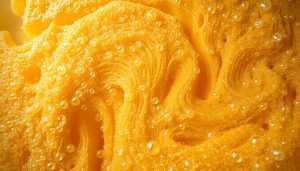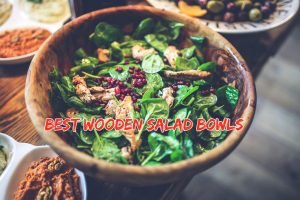Did you know 72% of participants in food studies prefer store-brand items over name brands when labels are hidden? This startling fact reveals how deeply sight influences flavor judgment. Removing visual cues creates a sensory reset, letting your tongue and nose become the true decision-makers.
Professionals from Michelin-starred kitchens to corporate labs use this method to strip away biases. Without packaging colors or ingredient lists, you’ll notice textures and aromas you’ve never detected before. Even simple foods like chocolate or coffee gain new dimensions when evaluated this way.
The practice isn’t just for experts. Hosting a dinner party where guests guess ingredients blindfolded turns meals into interactive adventures. You’ll laugh at mismatched guesses while sharpening your ability to identify spices or cooking techniques.
Key Takeaways
- Visual cues influence food preferences more than most people realize
- Hidden branding leads to more objective product evaluations
- Enhanced focus on texture and aroma improves flavor detection
- Group activities using this method boost engagement and learning
- Psychological expectations shape nearly 40% of flavor experiences
This approach reveals why some dishes disappoint despite beautiful plating – and why “ugly” foods often taste extraordinary. By resetting your expectations, you develop a palate that values substance over style.
Introduction to Blindfold Taste Testing
Your eyes trick your palate more than you realize. Vision controls nearly 80% of what you think you taste, according to food science research. Blocking sight activates hidden sensory superpowers in your mouth and nose.
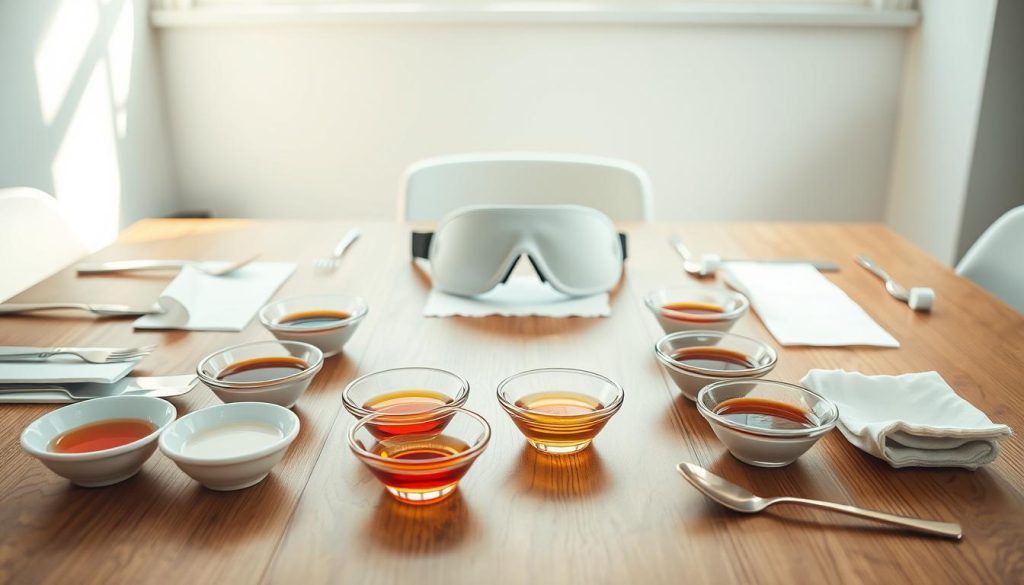
Understanding the Sensory Advantage
When visual distractions vanish, your taste receptors sharpen. Smell becomes 40% more precise, helping detect herbal notes in teas or spice blends in sauces. Texture gains new importance – you’ll notice creamy layers in cheeses or grain variations in breads.
The tongue’s five basic detectors work overtime during these experiments:
| Taste Type | Role | Common Sources |
|---|---|---|
| Sweet | Energy detection | Fruits, honey |
| Salty | Mineral balance | Seaweed, nuts |
| Sour | Acidity gauge | Citrus, yogurt |
| Bitter | Toxin alert | Dark greens, coffee |
| Umami | Savory depth | Mushrooms, aged meats |
Benefits of a Blind Taste Test
Brand labels and price tags lose their influence when samples are anonymous. Participants often prefer affordable options they’d normally overlook. One study found 68% chose store-brand crackers over premium versions when tested blindly.
This method also exposes hidden favorites. That “gourmet” olive oil collecting dust? It might lose to a budget bottle when appearance isn’t a factor. You’ll develop food opinions based on merit rather than marketing.
Setting Up Your Sensory Experiment
Proper setup transforms ordinary snacks into discovery tools. A well-organized space lets your group focus purely on flavors and textures. Follow these steps to eliminate distractions and sharpen sensory awareness.
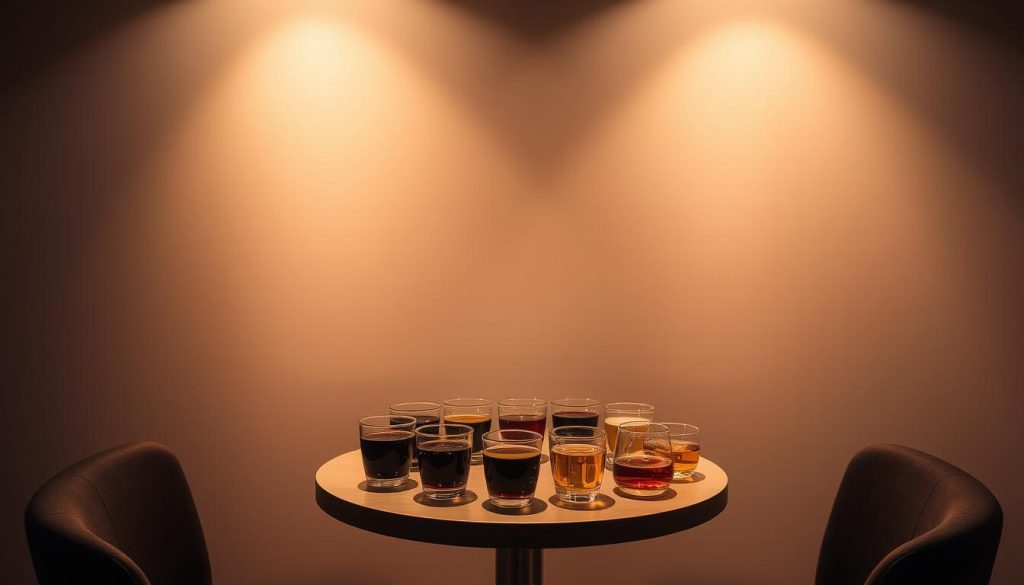
Gathering Essential Equipment
Start with basic tools that maintain anonymity. Use identical disposable plates and cups for each sample to avoid visual clues. Here’s what you’ll need:
| Equipment | Purpose | Pro Tip |
|---|---|---|
| Eye masks | Block visual bias | Test fit for light leakage |
| Numbered cups | Track foods drinks | Use non-transparent materials |
| Spit buckets | Prevent overconsumption | Place within arm’s reach |
| Rating cards | Capture instant reactions | Include texture/aroma scales |
Provide water and unsalted crackers between samples. This resets palates for accurate comparisons. Distribute pens with clipboards so participants can jot notes comfortably.
Creating a Focused Tasting Environment
Choose a neutral room without strong odors or decor. Soft instrumental music (50-60 decibels) reduces awkward silences. Consider these setup factors:
| Element | Ideal Condition | Common Mistake |
|---|---|---|
| Lighting | Bright but glare-free | Dim settings cause drowsiness |
| Seating | Armchair spacing | Cramped layouts distract |
| Utensils | White plastic forks | Metallic tastes interfere |
Position plates and cups at least 12 inches apart. This prevents accidental spills during blind taste trials. For group tests, assign a moderator to manage timing and answer questions.
Preparing Blindfolded Taste Samples
Mastering sample preparation unlocks the full potential of your blind taste test. Thoughtful selection and presentation let participants focus purely on what matters – the flavors and textures hidden in each bite or sip.
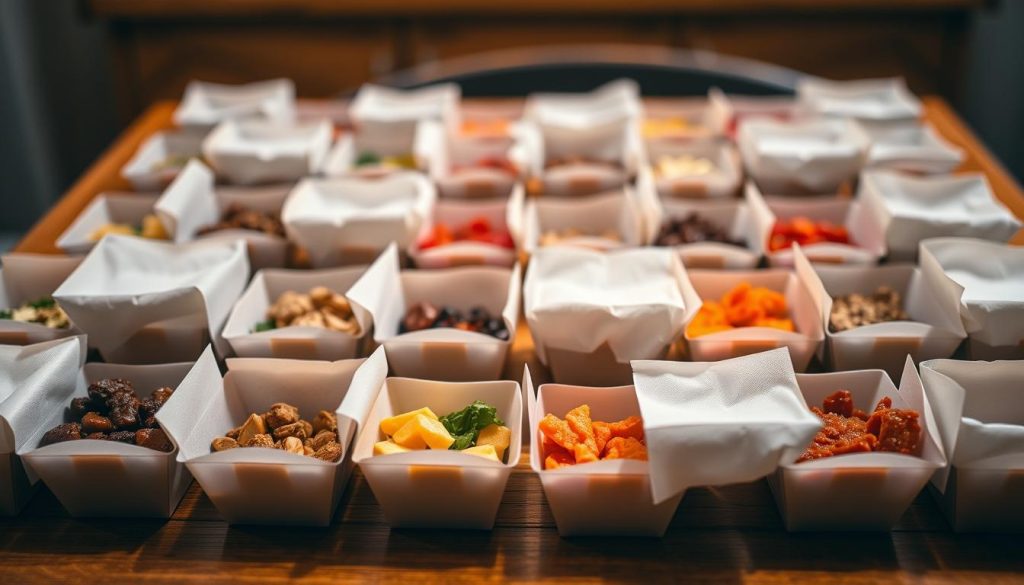
Selecting Foods and Drinks
Choose foods with distinct characteristics but similar formats. Compare dark chocolates with 60% vs 85% cocoa, or test oat milk against whole milk in coffee. Avoid mixing categories like sweet and savory to prevent sensory confusion.
| Category | Ideal Samples | Prep Notes |
|---|---|---|
| Chocolate | 70% dark vs milk | Cut into ½” cubes |
| Cheese | Aged cheddar vs gouda | 1 oz slices at 55°F |
| Coffee | Light vs dark roast | Brewed 30 seconds prior |
Uniform Sample Preparation
Use digital scales for identical portions – 15g for solids, 30ml for liquids. Serve all samples on white ceramic plates to eliminate color hints. Keep hot items at 140°F and cold ones below 40°F using thermal containers.
Anonymity and Presentation Tips
Label cups with random three-digit numbers (ex: #327) instead of letters. Store your master key in a sealed envelope until tests conclude. Place samples behind a partition when serving to hide accidental reveals.
Cover prepared foods with odorless lids until serving time. This preserves freshness while maintaining the mystery essential for unbiased flavor evaluation.
Taste Testing with a Blindfold: A Sensory Experiment
Clear guidelines transform casual sampling into precise analysis. Begin by demonstrating proper tasting techniques: lips closed, slow breathing through the nose, and deliberate chewing. This approach helps participants focus on subtle details often missed during rushed eating.
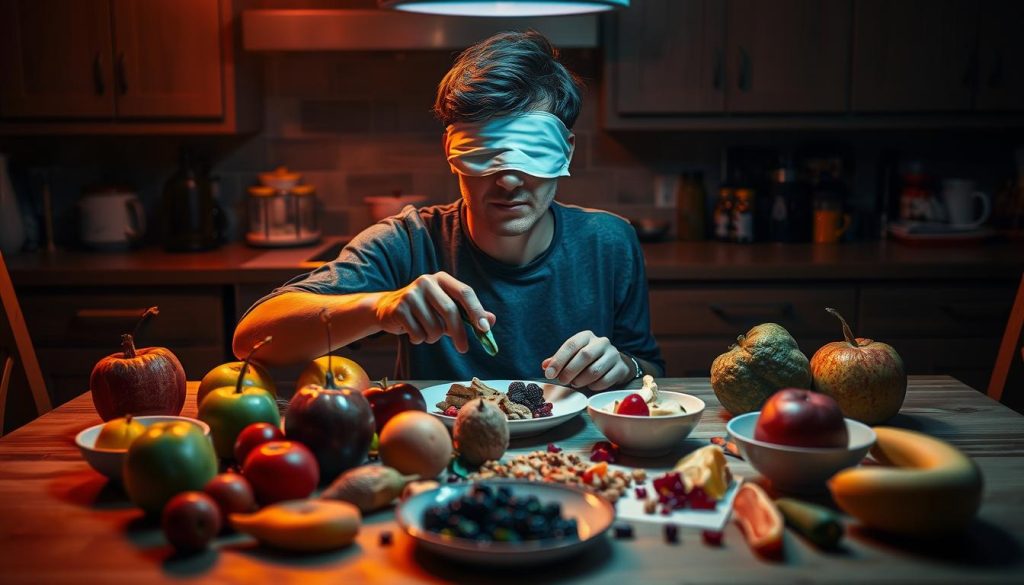
Structured Evaluation Protocol
Use this three-phase system to standardize responses:
| Phase | Duration | Focus Area |
|---|---|---|
| Initial Impression | 0-15 seconds | Surface textures & immediate flavors |
| Development | 15-45 seconds | Flavor evolution & mouthfeel |
| Finish | 45+ seconds | Aftertaste persistence & lingering sensations |
Provide rating sheets with specific criteria:
- Intensity scales (1-5) for sweetness and bitterness
- Checkboxes for texture descriptors like “gritty” or “silky”
- Open fields for unexpected observations
Between samples, insist on 30-second palate resets using room-temperature water. This prevents cumulative flavor distortion, especially when testing acidic items like citrus or vinegar-based products.
Maintain suspense by revealing product identities only after all scores get recorded. Participants often express surprise when budget items outperform premium counterparts in blind taste comparisons.
Enhancing Your Tasting Experience
The real magic happens after the blindfolds come off. Systematic data collection turns subjective opinions into actionable insights, revealing patterns that surprise even seasoned food enthusiasts.
Recording Observations and Feedback
Create scorecards with four rating columns: intensity (1-5), texture descriptors, aroma notes, and overall satisfaction. Use shorthand codes like “CIT” for citrus or “CRN” for caramel to speed up note-taking during fast-paced sessions.
Digital tools streamline this process. Spreadsheets with dropdown menus prevent inconsistent entries. Consider this sample data structure:
| Sample # | Sweetness | Texture | Key Notes |
|---|---|---|---|
| 328 | 3/5 | Gritty | Earthy, lingering finish |
| 415 | 4/5 | Creamy | Vanilla undertones |
Analyzing and Interpreting Results
Look for consensus outliers first. If 80% of participants rated sample #328 lowest, examine its common criticisms. Cross-reference demographic data – do coffee drinkers prefer bitter chocolates more than tea enthusiasts?
Color-code your spreadsheet to spot trends:
| Preference Pattern | Action Step |
|---|---|
| Consistent top choice | Compare price vs quality |
| Split opinions | Research cultural influences |
Qualitative comments often explain numerical ratings. Multiple mentions of “metallic aftertaste” might indicate packaging issues rather than ingredient quality. These insights help manufacturers improve recipes or guide consumers toward better purchases.
Creative Blind Taste Test Ideas
Transform ordinary gatherings into flavor discovery sessions with these inventive approaches. Explore snack varieties like kettle-cooked chips or artisanal popcorn to sharpen your group’s ability to detect subtle seasoning differences. Global options like Japanese matcha treats or Indian spice blends add cultural depth while testing sensory skills.
DIY Taste Challenges
Let participants craft mystery bites using random ingredients from your pantry. One might mix crushed pretzels into peanut butter cups, while another layers herbs into cream cheese spreads. This hands-on challenge reveals how creativity alters flavor perception when visual clues disappear.
Exploring Unconventional Flavors
Swap predictable chocolate comparisons for bold experiments. Test heat tolerance with pepper-infused honeys or identify cheese types through texture alone. Beverage battles – like discerning oat milk from almond in chai tea – highlight how liquids carry nuanced tastes without color cues.
These ideas turn routine snacks into adventures, proving that the best foods often surprise us when judged purely by mouthfeel and aroma. Whether hosting friends or refining your own palate, unconventional methods unlock flavors you’ve never truly tasted.

